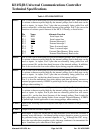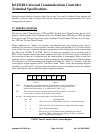
KS152JB Universal Communications Controller
Technical Specifications
Kawasaki LSI USA, Inc. Page 4 of 120 Ver. 0.9 KS152JB2
Port 3 Port 3 is an 8-bit bi-directional I/O port with internal pullups. Port 3 pins that have
1s written to them are pulled high by the internal pullups, and in that state can be
used as inputs. As inputs, Port 3 pins that are externally being pulled low will
source current (I
IL,
on the data sheet) because of the pullups. Port 3 also serves the
functions of various special features of the MCS-51 Family, as listed below:
Pin Name Alternate Function
P3.0 RXD Serial input line
P3.1 TXD Serial output line
P3.2
INT0 External interrupt 0
P3.3
INT1 External interrupt 1
P3.4 T0 Timer 0 external input
P3.5 T1 Timer 1 external input
P3.6
WR External Data Memory Write strobe
P3.7
RD External Data Memory Read strobe
Port 4 Port 4 is an 8-bit bi-directional I/O port with internal pullups. Port 4 pins that have
1s written to them are pulled high by the internal pullups, and in that state can be
used as inputs. As inputs, Port 4 pins that are externally being pulled low will
source current (I
IL,
on the data sheet) because of the internal pullups. In addition,
Port 4 also receives the low-order address bytes during program verification.
Port 5 Port 5 is an 8-bit bi-directional I/O port with internal pullups. Port 5 pins that have
1s written to them are pulled high by the internal pullups, and in that state can be
used as inputs. As inputs, Port 5 pins that are externally being pulled low will
source current (I
IL
, on the data sheet) because of the internal pullups.
Port 5 is also the multiplexed low-order address and data bus during accesses to
external program memory if EBEN is puled high. In this application it uses strong
pullups when emitting 1s.
Port 6 Port 6 is an 8-bit bi-directional I/O port with internal pullups. Port 6 pins that have
1s written to them are pulled high by the internal pullups, and in that state can be
used as inputs. As inputs, Port 6 pins that are externally pulled low will source
current (I
LL
, on the data sheet) because of the internal pullups. Port 6 emits the
high-order address byte during fetches from external Program Memory if EBEN
is pulled high. In this application it uses strong pullups when emitting 1s.
XTAL1 Input to the inverting oscillator amplifier and input to the internal clock generating
circuits.
XTAL2 Output from the oscillator amplifier.
RST Reset input. A logic low on this pin for three machine cycles while the oscillator is
running resets the device. An internal pullup resistor permits a power on reset to
be generated using only an external capacitor to V
SS
. Although the GSC recog-
nizes the reset after three machine cycles, data may continue to be transmitted for
up to 4 machine cycles after Reset is first applied.
Table 1: PIN DESCRIPTION


















